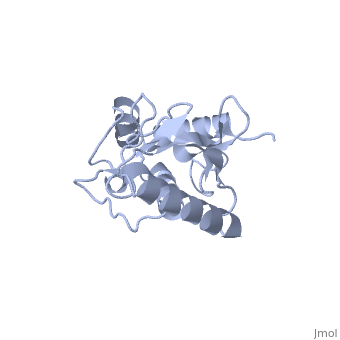Ubc9
From Proteopedia
(Difference between revisions)
| Line 1: | Line 1: | ||
<StructureSection load='1U9A' size='350' side='right' caption='Human Ubiquitin Conjugating Protein Ubc9 ' scene=''> | <StructureSection load='1U9A' size='350' side='right' caption='Human Ubiquitin Conjugating Protein Ubc9 ' scene=''> | ||
| + | |||
| + | Ubc9 is a ubiquitin-conjugating enzyme (E2) whose function involves transfer of ubiquitin or small ubiquitin-like modifier (SUMO) from activating enzyme (E1) to its designated substrate <ref>PMID:9261152</ref>. | ||
== Structure == | == Structure == | ||
| - | ''Ubc9'' exhibits a single domain structure consisting of both alpha helices and beta-pleated sheets. Cys93 has been identified as the active residue and is located on a loop of amino acids (78-108) between beta sheet four and alpha helix two <ref>PMID:9261152</ref>. | + | Murine/human ''Ubc9'' exhibits a single domain structure consisting of both alpha helices and beta-pleated sheets. Cys93 has been identified as the active residue and is located on a loop of amino acids (78-108) between beta sheet four and alpha helix two <ref>PMID:9261152</ref>. |
Revision as of 22:10, 24 February 2015
| |||||||||||
References
- ↑ Tong H, Hateboer G, Perrakis A, Bernards R, Sixma TK. Crystal structure of murine/human Ubc9 provides insight into the variability of the ubiquitin-conjugating system. J Biol Chem. 1997 Aug 22;272(34):21381-7. PMID:9261152
- ↑ Tong H, Hateboer G, Perrakis A, Bernards R, Sixma TK. Crystal structure of murine/human Ubc9 provides insight into the variability of the ubiquitin-conjugating system. J Biol Chem. 1997 Aug 22;272(34):21381-7. PMID:9261152

